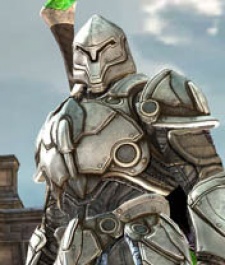The Infinity Blade series is a magnificent technical achievement.
For less than $10, you gain access to the most stunning graphics and scenario design on iOS, while the option of in-app purchases (IAPs) help you to slice through enemies like iTunes through your bank balance.
But with the free-to-play business model under scrutiny in terms of whether it overwhelms traditional game design mechanics for financial gain, do its IAPs contribute to the game's narrative and visual design as a whole?
Layered realities
In a recent interview, series creative director Donald Mustard stressed the amount of time spent on character design and architecture, especially in terms of Infinity Blade II.
'While on the surface it looks like traditional fantasy, we're slowly revealing ... that it's much more grounded in a science-fiction reality,' he explained; something that was signposted by the computer terminal discovered near the end of the first game.
The notion that fantasy is masking a science-fiction reality is skillfully explored in the visual design. For example, the main character's face is hidden by his helmet, so that while he looks like a medieval knight, he could be a humanoid robot or Halo's Master Chief.
On the surface
Aesthetically, there's also a limited palette of materials pervading the architecture and the character design.
Almost everything is stone or steel. All life is artificial, forged and constructed from the same materials as the built environment through which the character travels. The organic is always concealed under a cyborg shell.
The only exceptions are the occasional use of bone or hair in the costumes of the already monstrous enemies. The contrast between man, the warrior engineer, and the brutal strength of nature red in tooth and claw - something for the hero to conquer with his technology - is obvious.
Accessorise me
But so much for the scenario. How does this feed into the items available to the player?
For one thing, there's a dazzling array of weapons to choose from, especially if you're prepared to spend additional cash.
Many bring a splash of colour to the screen, catching the eye with dazzling good looks that step beyond the game world's otherwise limited palette. And some introduce science-fiction styles that are barely hinted at in the standard scenario design.
It's a strong visual sign that buying IAP will have a tangible impact on your play experience.
Architecture that pays
Of course, not everyone wants to spend additional cash, although around 50 percent of Infinity Blade players do buy IAP. But even they need encouragement, and that's how the in-game currency system works.
If you pay attention to the architecture, it will pay you back. Skipping through cutscenes is possible, but not best policy; you're rewarded for appreciating the gorgeous scenario design.
Some careless person - a careful designer - has left bags of gold lying around everywhere, and it's yours if you spot them quickly enough.
It's certainly a contrivance that feels out of place in the grounded architectural design of Infinity Blade, but that's the devil you dance with for adopting the business model.
For this little detail can be a driving force in your virtual goods experience.
Finding sacks of coins lying around makes you feel flush. You're keen to find cool items on which to spend your newfound wealth, even if many are shockingly expensive. Plus, some retail therapy is a well-deserved reward after succeeding at the skill test of collecting the cash before the camera pans away.
Shopping is magic
When it comes to the actual retail experience, the game's store is a fluid extension of your own inventory of items, if abstracting the transaction from the magic circle of the game world.
There is no place for cheery NPC merchants on the lonely road to the top of the tower. But smoothly scrolling through the options available makes it easy to compare, at a glance, the attributes and visual appeal of each weapon or armour item.
Elaborate flourishes adorn the paid items in a way not seen on the rarely-dropped free alternatives.
While staying broadly within the art style of the game, there is something to suit every vain whim and combat style.
The more you play, the more your eye gets drawn towards highly expensive but undeniably tempting items, such as rings with powerful magic attacks, sleek armour that increases attack speed, or the eponymous infinity blade won at the end of the first game, and lost at the start of the sequel.
While the cheaper items cost a couple of thousand gold, elite items cost hundreds of thousands of in-game coins.
In this way, the more you play, the items you're really drawn to are the ones that you can never buy relying on in-game coin drops. But the more coins you collect, the more you're encouraged to directly spend real world cash in-game.
Initially, it was discouraging not to be able to buy my coveted Night Armour, but soon after I found a lot of coins in the game - although still not enough - it was sufficient to make me consider a purchase. After all, I was already part way there.
My phone becomes me
But let's wrap up by returning to the underlying science-fiction reality of the game.
Your nemesis - the God King - is almost certainly a cyborgian figure, even if not literally a cyborg. He's constantly reanimated using unknown technological interventions. His fleshy body could not survive alone on the battleground; he is dependent on the modifications that he finds in treasure chests that players buy for him.
And the image of the cyborg is very compelling on a mobile device. To a degree, we have all been cyborgised by smartphones; for example, many of us have the spatial intelligence of children if we can't access Google maps.
Enhance me
However, the significance of the cyborg narrative goes even deeper, right to the monetisation model itself.
So long as a game is item-focused, cyborgisation is going to be a compelling narrative. It's like a William Gibson novel. Every enhancement provides an edge in the world. That edge is thrilling, intoxicating, and is also necessary for survival.
That's exactly what's happening in Infinity Blade.
Your in-app purchases - many of which look appropriately cyberpunk - give your on-screen character an edge in that beautiful, rich virtual world. Spending power translates into mythic, warrior power. Materials modify the self.
We spend cash to improve our status in a world that doesn't exist, except in the community of Game Center, in which we're ranked against the rest of the world.
So if we - as 21st Century smartphone owners - on some level feel an affinity with the idea of the cyborg, it follows that we will feel the situation in Infinity Blade reflects our own.
It's not just that our character is getting stronger the more we spend, but also that we need to spend more as more powerful enemies are arrayed before us. It's not about skill. It's about skill and the ability feel as though we're in control of our destiny - even if that is mediated through cold, hard cash.
And with such a narrative, it's no surprise that each and every in-app purchase in Infinity Blade feels like a joyous victory in itself.
Zoya will be giving a talk at GDC on Thursday 8 March at 1pm on the historical study of in-game objects within Final Fantasy.
Game design historian Zoya Street deconstructs how IAPs fit into the design aesthetics of Infinity Blade
Of stone, steel and cyborgs





















